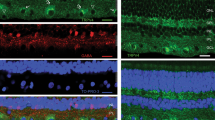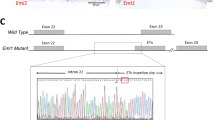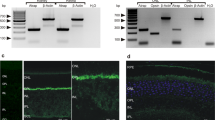Abstract
In the mammalian retina, A17 amacrine cells provide reciprocal inhibitory feedback to rod bipolar cells, thereby shaping the time course of visual signaling in vivo. Previous results have indicated that A17 feedback can be triggered by Ca2+ influx through Ca2+-permeable AMPA receptors and can occur independently of voltage-gated Ca2+ (Cav) channels, whose presence and functional role in A17 dendrites have not yet been explored. We combined electrophysiology, calcium imaging and immunohistochemistry and found that L-type Cav channels in rat A17 amacrine cells were located at the sites of reciprocal synaptic feedback and that their contribution to GABA release was diminished by large-conductance Ca2+-activated potassium (BK) channels, which suppress postsynaptic depolarization in A17s and limit Cav channel activation. We also found that BK channels, by limiting GABA release from A17s, regulate the flow of excitatory synaptic transmission through the rod pathway.
This is a preview of subscription content, access via your institution
Access options
Subscribe to this journal
Receive 12 print issues and online access
$209.00 per year
only $17.42 per issue
Buy this article
- Purchase on Springer Link
- Instant access to full article PDF
Prices may be subject to local taxes which are calculated during checkout








Similar content being viewed by others
References
Dunn, F.A., Doan, T., Sampath, A.P. & Rieke, F. Controlling the gain of rod-mediated signals in the mammalian retina. J. Neurosci. 26, 3959–3970 (2006).
Hartveit, E. Reciprocal synaptic interactions between rod bipolar cells and amacrine cells in the rat retina. J. Neurophysiol. 81, 2923–2936 (1999).
Nelson, R. & Kolb, H. A17: a broad-field amacrine cell in the rod system of the cat retina. J. Neurophysiol. 54, 592–614 (1985).
Singer, J.H. & Diamond, J.S. Sustained Ca2+ entry elicits transient postsynaptic currents at a retinal ribbon synapse. J. Neurosci. 23, 10923–10933 (2003).
Dong, C.J. & Hare, W.A. Temporal modulation of scotopic visual signals by A17 amacrine cells in mammalian retina in vivo. J. Neurophysiol. 89, 2159–2166 (2003).
Chavez, A.E., Singer, J.H. & Diamond, J.S. Fast neurotransmitter release triggered by Ca influx through AMPA-type glutamate receptors. Nature 443, 705–708 (2006).
Menger, N. & Wassle, H. Morphological and physiological properties of the A17 amacrine cell of the rat retina. Vis. Neurosci. 17, 769–780 (2000).
Faber, E.S., Delaney, A.J. & Sah, P. SK channels regulate excitatory synaptic transmission and plasticity in the lateral amygdala. Nat. Neurosci. 8, 635–641 (2005).
Hu, H. et al. Presynaptic Ca2+-activated K+ channels in glutamatergic hippocampal terminals and their role in spike repolarization and regulation of transmitter release. J. Neurosci. 21, 9585–9597 (2001).
Liu, S. & Shipley, M.T. Multiple conductances cooperatively regulate spontaneous bursting in mouse olfactory bulb external tufted cells. J. Neurosci. 28, 1625–1639 (2008).
Maher, B.J. & Westbrook, G.L. SK channel regulation of dendritic excitability and dendrodendritic inhibition in the olfactory bulb. J. Neurophysiol. 94, 3743–3750 (2005).
Ngo-Anh, T.J. et al. SK channels and NMDA receptors form a Ca2+-mediated feedback loop in dendritic spines. Nat. Neurosci. 8, 642–649 (2005).
Raffaelli, G., Saviane, C., Mohajerani, M.H., Pedarzani, P. & Cherubini, E. BK potassium channels control transmitter release at CA3-CA3 synapses in the rat hippocampus. J. Physiol. (Lond.) 557, 147–157 (2004).
Skinner, L.J. et al. Contribution of BK Ca2+-activated K+ channels to auditory neurotransmission in the guinea pig cochlea. J. Neurophysiol. 90, 320–332 (2003).
Womack, M.D. & Khodakhah, K. Somatic and dendritic small-conductance calcium-activated potassium channels regulate the output of cerebellar purkinje neurons. J. Neurosci. 23, 2600–2607 (2003).
Xu, J.W. & Slaughter, M.M. Large-conductance calcium-activated potassium channels facilitate transmitter release in salamander rod synapse. J. Neurosci. 25, 7660–7668 (2005).
Hicks, G.A. & Marrion, N.V. Ca2+-dependent inactivation of large conductance Ca2+-activated K+ (BK) channels in rat hippocampal neurones produced by pore block from an associated particle. J. Physiol. (Lond.) 508, 721–734 (1998).
Orio, P., Rojas, P., Ferreira, G. & Latorre, R. New disguises for an old channel: MaxiK channel beta-subunits. News Physiol. Sci. 17, 156–161 (2002).
Wallner, M., Meera, P. & Toro, L. Molecular basis of fast inactivation in voltage and Ca2+-activated K+ channels: a transmembrane beta-subunit homolog. Proc. Natl. Acad. Sci. USA 96, 4137–4142 (1999).
Berkefeld, H. et al. BKCa-Cav channel complexes mediate rapid and localized Ca2+-activated K+ signaling. Science 314, 615–620 (2006).
Marty, A. Ca-dependent K channels with large unitary conductance in chromaffin cell membranes. Nature 291, 497–500 (1981).
Meredith, A.L. et al. BK calcium-activated potassium channels regulate circadian behavioral rhythms and pacemaker output. Nat. Neurosci. 9, 1041–1049 (2006).
Sun, X., Gu, X.Q. & Haddad, G.G. Calcium influx via L- and N-type calcium channels activates a transient large-conductance Ca2+-activated K+ current in mouse neocortical pyramidal neurons. J. Neurosci. 23, 3639–3648 (2003).
Zhang, J., Li, W., Trexler, E.B. & Massey, S.C. Confocal analysis of reciprocal feedback at rod bipolar terminals in the rabbit retina. J. Neurosci. 22, 10871–10882 (2002).
Partin, K.M., Patneau, D.K., Winters, C.A., Mayer, M.L. & Buonanno, A. Selective modulation of desensitization at AMPA versus kainate receptors by cyclothiazide and concanavalin A. Neuron 11, 1069–1082 (1993).
Treiman, M., Caspersen, C. & Christensen, S.B. A tool coming of age: thapsigargin as an inhibitor of sarco-endoplasmic reticulum Ca2+-ATPases. Trends Pharmacol. Sci. 19, 131–135 (1998).
Mitra, P. & Slaughter, M.M. Mechanism of generation of spontaneous miniature outward currents (SMOCs) in retinal amacrine cells. J. Gen. Physiol. 119, 355–372 (2002).
Habermann, C.J., O'Brien, B.J., Wassle, H. & Protti, D.A. AII amacrine cells express L-type calcium channels at their output synapses. J. Neurosci. 23, 6904–6913 (2003).
Ghosh, K.K., Haverkamp, S. & Wassle, H. Glutamate receptors in the rod pathway of the mammalian retina. J. Neurosci. 21, 8636–8647 (2001).
Euler, T. & Masland, R.H. Light-evoked responses of bipolar cells in a mammalian retina. J. Neurophysiol. 83, 1817–1829 (2000).
Wang, Y.W., Ding, J.P., Xia, X.M. & Lingle, C.J. Consequences of the stoichiometry of Slo1 alpha and auxiliary beta subunits on functional properties of large-conductance Ca2+-activated K+ channels. J. Neurosci. 22, 1550–1561 (2002).
Yang, X.L., Gao, F. & Wu, S.M. Non-linear, high-gain and sustained-to-transient signal transmission from rods to amacrine cells in dark-adapted retina of Ambystoma. J. Physiol. (Lond.) 539, 239–251 (2002).
Ellias, S.A. & Stevens, J.K. The dendritic varicosity: a mechanism for electrically isolating the dendrites of cat retinal amacrine cells? Brain Res. 196, 365–372 (1980).
Yasuda, R. et al. Imaging calcium concentration dynamics in small neuronal compartments. Sci. STKE 219, l5 (2004).
Acknowledgements
We thank C. McBain for critically reading the manuscript, members of the Diamond and Isaac laboratories for helpful discussions and E. Compton-Daw for assistance with spectrophotometry. This work was supported by the US National Institute of Neurological Disorders and Stroke Intramural Research Program.
Author information
Authors and Affiliations
Contributions
W.N.G. conducted the electrophysiological and two-photon imaging experiments. W.L. carried out the immunohistochemistry experiments. A.E.C. performed preliminary electrophysiological experiments contributing to the formulation of the project. W.N.G., A.E.C. and J.S.D. designed the experiments. W.N.G. and J.S.D. wrote the manuscript.
Corresponding author
Supplementary information
Supplementary Text and Figures
Supplementary Figure 1 (PDF 118 kb)
Rights and permissions
About this article
Cite this article
Grimes, W., Li, W., Chávez, A. et al. BK channels modulate pre- and postsynaptic signaling at reciprocal synapses in retina. Nat Neurosci 12, 585–592 (2009). https://doi.org/10.1038/nn.2302
Received:
Accepted:
Published:
Issue Date:
DOI: https://doi.org/10.1038/nn.2302
This article is cited by
-
Large-conductance calcium-activated potassium channel haploinsufficiency leads to sensory deficits in the visual system: a case report
Journal of Medical Case Reports (2022)
-
Electrical coupling between A17 cells enhances reciprocal inhibitory feedback to rod bipolar cells
Scientific Reports (2018)
-
Inhibition decorrelates visual feature representations in the inner retina
Nature (2017)
-
BK channel inactivation gates daytime excitability in the circadian clock
Nature Communications (2016)
-
Cannabinoid CB1 receptor signaling dichotomously modulates inhibitory and excitatory synaptic transmission in rat inner retina
Brain Structure and Function (2016)



